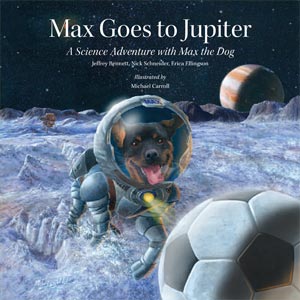 Max Goes to Jupiter was illustrated by Michael Carroll. Michael worked from real models for the main characters; he then added the backgrounds as needed for the different Earth and space scenes. He uses a combination of painting and computer-generated art. Below is a list of some special things to look for in the paintings. We have also included a few other special notes of interest.
Max Goes to Jupiter was illustrated by Michael Carroll. Michael worked from real models for the main characters; he then added the backgrounds as needed for the different Earth and space scenes. He uses a combination of painting and computer-generated art. Below is a list of some special things to look for in the paintings. We have also included a few other special notes of interest.
- Cover: We see Max bounding across the ice on the surface of Europa, with Jupiter hanging in the sky in the background. You can see that Max is chasing his soccer ball — which means this cover scene takes place shortly before his ball comes to rest as shown on p. 23.
- p. 3. This scene was actually posed and photographed in front of the "Science on a Sphere" exhibit at the Fiske Planetarium in Boulder, Colorado. The sphere can be made to show any planet, but here it shows Jupiter; the whitish spot on Jupiter’s upper right is actually a reflection from the camera flash! The sphere is showing Jupiter, and you can see its real size in the exhibit as it compares to the people. Notice that Nathan is holding a globe of Earth — this globe is shown at the correct scale relative to the size of Jupiter; as you can see, Earth is smaller than Jupiter’s Great Red Spot, which is visible near the lower right of Jupiter.
- p. 4-5: In addition to Tori, Nathan, and Max, the characters here also include Emily Schneider, daughter of authors Nick Schneider and Erica Ellingson (and Nathan is their son), and Grant Bennett, son of author Jeffrey Bennett. The other dog is Jasper, who lives with the Schneider/Ellingson family.
- p. 6: Commander Grant shows the kids a picture from "grandpa" Max’s first trip to the Moon; you’ll recognize the picture as the cover of Max Goes to the Moon. The little girl holding the puppy Max (whose real name is Cosmo) is author Bennett’s daughter Brooke.
- p. 7: This next scene takes place a couple years after the scene on p. 6. Notice that Max is again sitting on Brooke’s lap, but he’s grown a lot more than she has!
- p. 8: Max (real name Cosmo) really does jump at dog treats as shown here. Notice that the papers flying around the room are from Nathan’s report an show each of the four Galilean moons: Io, Europa, Ganymede, and Callisto.
- p. 10: As you might imagine, this scene was very difficult to pose! Two of the authors actually helped hold Max and Nathan in the positions shown while the artist snapped the photo; the artist then painted without the authors, so it would look like the crash to the ground really was in progress.
- p. 11: This scene takes place at the base of the Space Elevator. Notice the platform is in the ocean, and you can see the cable heading up into the sky.
- p. 12: Now you can see the full context of the Space Elevator, since this view shows it extending all the way to the top from the small Earth down in the lower right corner. Notice the "hotel" at the top of the elevator, and if you look closely, you’ll see the Jupiter ship anchored at the very top. See pages 21 or 25 for a closer-up view of the spaceship.
- p. 13: To get the full context of this painting, compare it to the views of the spaceship from outside on pages 21 or 25. You’ll see that we are looking at the round part of the spaceship as it appears on the inside, where the astronauts and Max can walk around because the round portion is rotating.
- p. 14-15: Be sure to notice the tiny blue Earth, which is far in the distance below Jupiter’s limb on the right side of the page. As noted on the credits page (p. 2), Captain Anousheh was the first astronaut of Iranian heritage, and Commander Grant is modeled by Lado Jurkin, one of the "Lost Boys of Sudan."
- p. 16: We’re looking from inside the airlock into the main ship; notice Max coming to a grinding halt as the door closes in front of him, despite the fact that his soccer ball went into the airlock. You can also see the Jupiter probe hanging inside the airlock.
- p. 17: To the lower left you can see the probe heading toward Jupiter, while Max’s soccer ball flies out into space at the upper right. You’ll see some extra balls inside the ship on a shelf, so that he still has others to play with even though this first one is gone.
- p. 18-19: This painting shows a realistic view of being on the surface of Io. Notice the erupting volcano in the distance on the right page. Also notice that Max’s helmet is covered with the sticky, yellow dust, which is also all over his spacesuit and the spacesuits of the astronauts. Commander Grant is running toward Max on the right page, while Tori (on the left page) is calling for Max.
- Io surface gravity: Although it does not come up in the story, many kids ask about surface gravity on Io; it is about 18% that on Earth, which means it is slightly more than on our own Moon.
- p. 20: This scene takes place in the lander as it rises back up from Io to the main ship; notice Io out the window, pockmarked with volcanoes.
- p. 21: Now we get a good view of the entire spaceship, along with Europa in the background and Jupiter behind that to the lower right of the page.
- p. 22-23: This scene shows a realistic view of the surface of Europa, with Max resting near his ball as Commander Grant calls over the astronauts bringing the robotic submarine. Note that the submarine is fairly small — since it is robotic, there’s no need for it to be very large.
- Europa surface gravity: The story tells reminds us that gravity is weak on Europa. How weak? It’s about 1/7 that of Earth (more precisely, 0.135), which means the surface gravity is slightly less on Europa than on our own Moon.
- p. 26: Lots of kids have asked us, "What do the living creatures look like?" Well… Of course the crew can see them, but you can’t because the video screen is facing the crew rather than the reader. We did that on purpose, so that you’d be forced to use your own imagination to decide what you think the creatures might look like.
- p 27: This painting of a school in rural Africa shows the kids working with laptops from the "one laptop per child" project, as they analyze real data from the Jupiter mission.
